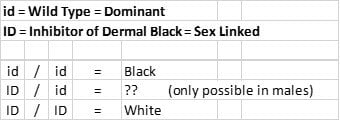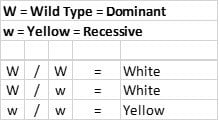I just spent an hour trying to get basic genetics info about leg color and not getting very far. My main question is about yellow legs. Are they dominant or recessive? Is yellow dominant or recessive to willow? Sex linked or not?
Here's my situation. I am starting a white line of Araucanas. Two years ago I hatched a random recessive white cockerel from a BBR hen and ER/e cockbird. Last year I bred the recessive white cockerel back to his mother and hatched about 50% whites from them. Last fall another Araucana breeder and I traded birds, and I got a lovely dominant white pullet from her. I've been breeding this pullet to my best white cockerel from last year. My cockerel has a mix of willow and yellow legs. I know, weird, but its as if they are mostly yellow with a willow overwash in spots. (You may have to zoom in on the pics to see). The pullet has lovely yellow legs. I'm on my second hatch from the pair and it seems I'm getting more willow legs than yellow. The total I've hatched is only 10, so I can't really go by the percentage of willow vs. yellow on which is dominant.
The total I've hatched is only 10, so I can't really go by the percentage of willow vs. yellow on which is dominant.
So which shank color is dominant? Is yellow sex linked? Thank you in advance.


Here's my situation. I am starting a white line of Araucanas. Two years ago I hatched a random recessive white cockerel from a BBR hen and ER/e cockbird. Last year I bred the recessive white cockerel back to his mother and hatched about 50% whites from them. Last fall another Araucana breeder and I traded birds, and I got a lovely dominant white pullet from her. I've been breeding this pullet to my best white cockerel from last year. My cockerel has a mix of willow and yellow legs. I know, weird, but its as if they are mostly yellow with a willow overwash in spots. (You may have to zoom in on the pics to see). The pullet has lovely yellow legs. I'm on my second hatch from the pair and it seems I'm getting more willow legs than yellow.
 The total I've hatched is only 10, so I can't really go by the percentage of willow vs. yellow on which is dominant.
The total I've hatched is only 10, so I can't really go by the percentage of willow vs. yellow on which is dominant.So which shank color is dominant? Is yellow sex linked? Thank you in advance.







